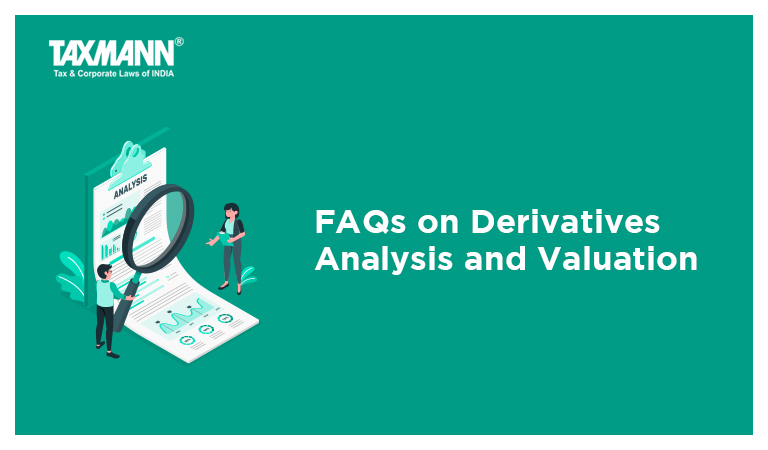FAQs on Derivatives Analysis and Valuation
- Other Laws|Blog|
- 4 Min Read
- By Taxmann
- |
- Last Updated on 22 September, 2022
An embedded derivative is a derivative instrument that is embedded in another contract, called the host contract. The host contract might be a debt or equity instrument, a lease, an insurance contract or a sale or purchase contract. They are a result of financial engineering, though some may arise inadvertently due to market practices and contracting arrangements. There is intentional shifting of risks between the parties. They may cause modification to a contract’s cash flow, if there is any change in specified variable. A derivative requires to be marked to market through the Income statement. Embedded derivatives are also marked-to-market. This requirement on embedded derivative is designed to ensure that mark-to-market is not avoided by including or embedding a derivative in another contract or financial instrument which is not marked-to-market through the Income statement.
The following are the points of difference between a Future contract and an option contract. Basis Future contract Option contract
The derivative instruments are the outcome of financial engineering and their value is based on some underlying asset. The underlying may be a share, a commodity or any other asset which has a marketable value which is subject to market risks. The importance of underlying in derivative instruments is as follows:
The following are the assumptions of Black Scholes Model;
The price of an option is a function of spot price, exercise price, time to expiration, risk free rate of return, volatility and dividends. These are explained as follows:
It is the degree to which an option price will move, given a small change in the underlying stock price. A deeply out of money call will have delta very close to zero and a deeply in the money call will have a delta close to 1. For example, if the delta is 0.1, Re.1 change in underlying will change the value of option by Re. 0.10. If delta is 0.95, a Re.1 change in underlying will change the value of option by Rs. 0.95.
It measures how fast the delta changes for a small change in the underlying stock price. It is the delta of the delta. If a portfolio is hedged using delta-hedge technique, the gamma should be small. A small gamma will not bring much change in the delta and therefore portfolio will not require adjustment.
It measures the sensitivity of option value to change in volatility. Vega indicates an absolute change in option value for a one percentage change in volatility.
It measures the sensitivity of option value to change in interest rate. It is the change in option price given a one percentage point change in the risk-free interest rate. Rho indicates the absolute change in option value for a one percent change in the interest rate.
FAQ 1. What are Embedded Derivatives?
FAQ 2. What is the difference between a Future contract and an Option contract?
Definition
A future contract is a contract between two parties to exchange assets or services at a specified time in the future at a price agreed upon at the time of the contract. It is exchange traded.
An option is a contractual agreement that gives the option buyer the right, but not the obligation, to purchase or to sell a specified instrument at a specified price at any time before maturity or on maturity. It is exchange traded.
Settlement/Cash Flow
Profit/Loss is settled on a daily basis based on movement in current Future prices.
Option writer collects premium at the inception of the contract.
Price Fixation
Determined by the market forces.
Exercise price fixed by the stock exchange. Premium is market driven.
Obligation to perform
Both the parties are under obligation to perform.
Only the writer of the option is under obligation to perform. The option buyer has discretion.
Closure of Contract
FAQ 3. What is the significance of an underlying asset in relation to a Derivative Instrument?
FAQ 4. What are the various assumptions of the Black Scholes Model?
FAQ 5. Which are the factors affecting value of an Option?
FAQ 6. What is Delta in respect of Options?
FAQ 7. What is Gamma in respect of Options?
FAQ 8. What is Vega in respect of Options?
FAQ 9. What is Rho in respect of Options?
Disclaimer: The content/information published on the website is only for general information of the user and shall not be construed as legal advice. While the Taxmann has exercised reasonable efforts to ensure the veracity of information/content published, Taxmann shall be under no liability in any manner whatsoever for incorrect information, if any.

Taxmann Publications has a dedicated in-house Research & Editorial Team. This team consists of a team of Chartered Accountants, Company Secretaries, and Lawyers. This team works under the guidance and supervision of editor-in-chief Mr Rakesh Bhargava.
The Research and Editorial Team is responsible for developing reliable and accurate content for the readers. The team follows the six-sigma approach to achieve the benchmark of zero error in its publications and research platforms. The team ensures that the following publication guidelines are thoroughly followed while developing the content:
- The statutory material is obtained only from the authorized and reliable sources
- All the latest developments in the judicial and legislative fields are covered
- Prepare the analytical write-ups on current, controversial, and important issues to help the readers to understand the concept and its implications
- Every content published by Taxmann is complete, accurate and lucid
- All evidence-based statements are supported with proper reference to Section, Circular No., Notification No. or citations
- The golden rules of grammar, style and consistency are thoroughly followed
- Font and size that’s easy to read and remain consistent across all imprint and digital publications are applied



 CA | CS | CMA
CA | CS | CMA
